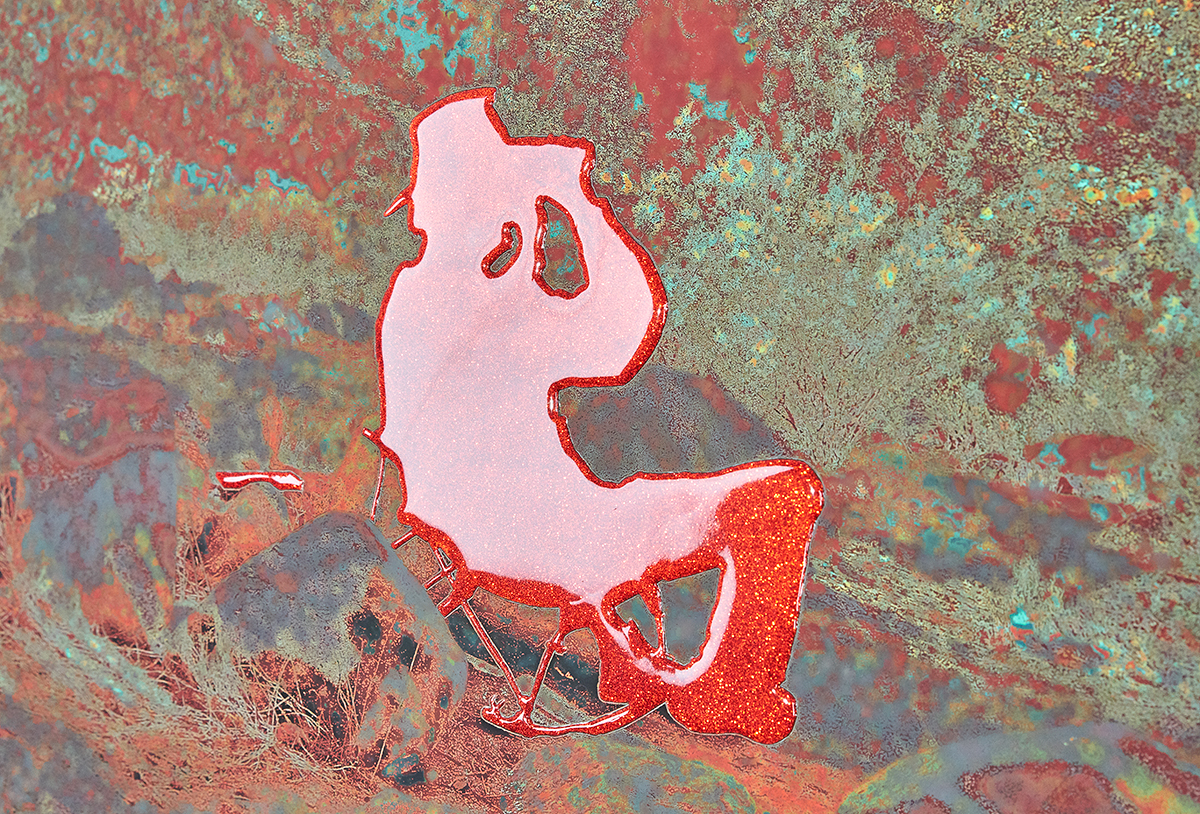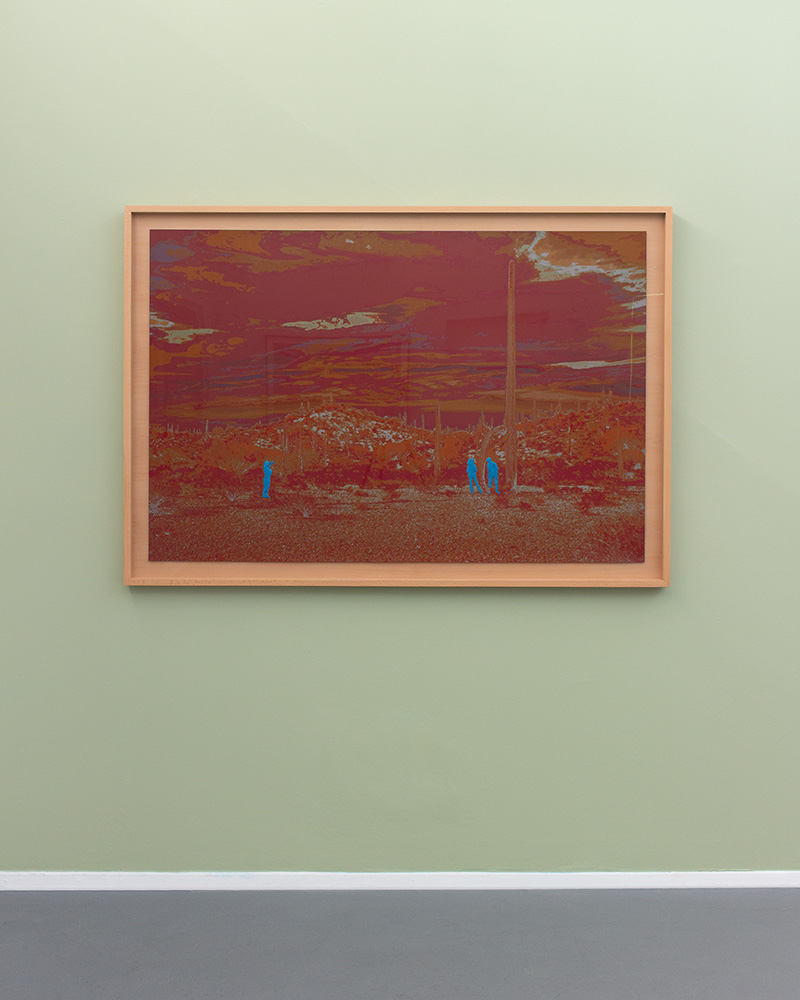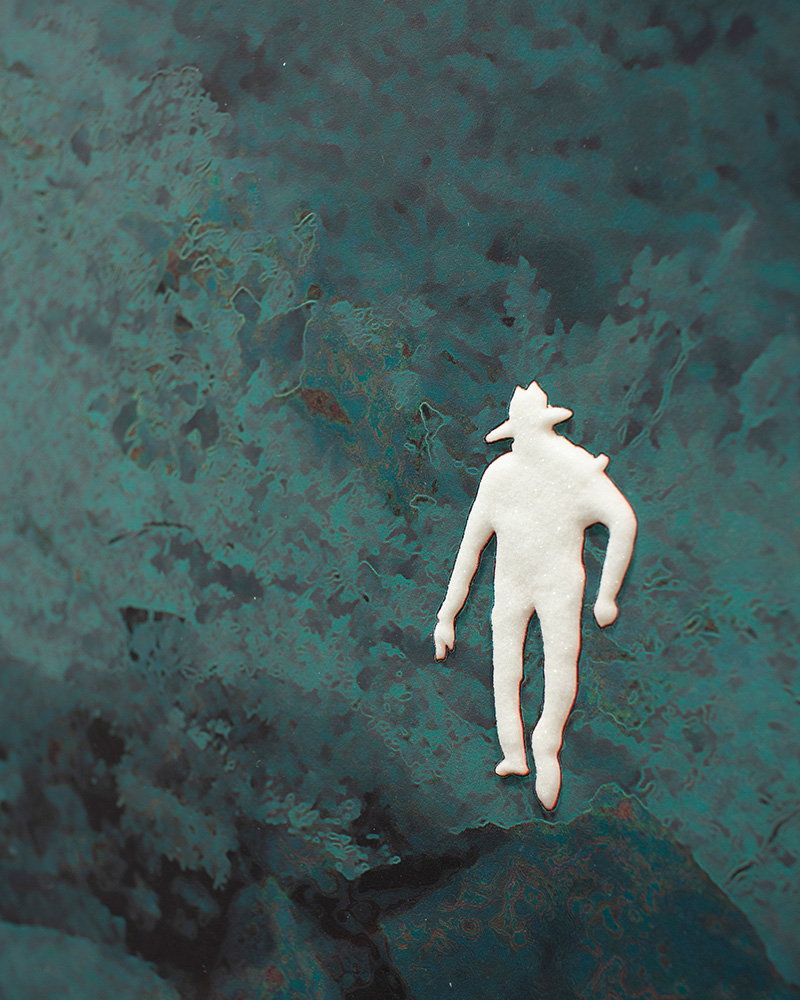John Brinton Hogan: Visual Aphasia

©John Brinton Hogan, Artists at the SASCO Site, North of Tucson, Arizona, January 2017 (Brick Red and Grey with Yellow Glitter Blisters) 2017 Mixed media on cotton paper 28 x 41 inches (71 x 104 cm) Unique
San Diego artist John Brinton Hogan recently opened an exciting and other-worldly solo exhibition, Visual Aphasia, at Marshall Contemporary in Los Angeles. The show will run through June 19th, 2021. Hogan’s mixed media landscapes provide the perfect metaphoric acid trip into unknown worlds, especially interesting in a time when we tiptoe back into the reality of everyday life, much changed and considered in the past year. These color soaked vistas are a rich stew of photography, digital art, and painting, allowing for a new kind of photographic artistry, intervened unapologetically with glossy paints, glitter, holographic and appliqué. At once surreal and magical, Hogan’s works straddle the narrative of explorer and last man standing, obscured individuals in search for something the land has to offer. The landscapes are distorted, flattened, and made more painterly through a series of processes. The figures rise up out of their surroundings and are layered with acrylic media that calls to mind the Colorforms I played with as a child. These layers, sometimes with 20+ coats, are what the artist refers to as “blisters”. There is something so fantastical about these large scale sci-fi landscapes with figures wandering inhospitable terrains, wearing glittered and rubber bodysuits–it’s the excitement of seeing an artist challenge the norm and simply delight us with his unique methodology.
Last night, I found my husband watching old Star Trek episodes in the dark and I had a moment of recognition that perhaps this work is predicting future explorations into places that are at once familiar, yet not. It’s as if Hogan is telling us that “these are the voyages of the photography today. Its five-year mission: to explore strange new worlds. To seek out new life and new civilizations. To boldly go where no photographer has gone before!” All I can say is, sign me up! A short interview with the artist follows.
John Brinton Hogan’s work examines ideas, issues, and artistic interpretation associated with landscape and land use, primarily in the American west. He has exhibited around the world, and his pieces are held in public, institutional, and private collections. Self-educated, he refined his technical skills photographing professional skateboarding during its resurgence in the 1980’s, and later worked as a commercial photographer and filmmaker in New York City and Los Angeles. He resides in San Diego, CA.
His most recent body of work, entitled Visual Aphasia, examines the prospect of a post-human Earth. While images are drawn from photographs made in the field, the extreme distortion of their components creates an alien, inhospitable world, one whose visual details we’ve so far only imagined. In this work, sci-fi novel illustrations, 70’s album covers, and “Finish Fetish” references combine to produce a document describing our species’ possible future. By employing materials normally associated with lighthearted household craft (glossy paints, glitter, holographic appliqué), tension develops between the aura of childlike wonder and paranoid uncertainty, simultaneously rendering the human presence both familiar and unrecognizable. IG: @johnbrintonhogan @marshallcontemporary

©John Brinton Hogan, Volunteer Searching for Endangered Peninsular Desert Bighorn Sheep, Anza-Borrego Desert State Park, California, July 2018 (Red, Turquoise, Green with Red Glitter Blisters) 2019 Mixed media on cotton paper 30 x 41 1/2 inches (76 x 105 cm) Unique
Let’s start at the beginning, tell us a little bit about your growing up and what brought you to photography.
My father was involved in motor racing, and brought me along to various events which often required long trips by car. During those hours on the road, my little boy’s mind wondered about the histories of the landscapes I was viewing through the windshield… the stories of prospectors, cowboys, dangerous animals, doomed expeditions- they were all fascinating to imagine.
I wanted to be a painter, but feared I couldn’t draw well enough, so looked for other means of artistic expression. I was given a small camera, which I used to take blurry close-ups of racing-car numerals, much to my father’s annoyance.
As a young man, I found myself with a job in the skateboarding industry. One of my responsibilities was to photograph the professional skateboarders on my team, and I was given a nice camera to perform the task. Other than a high school photo class, I have no formal training… My education came through experience, experimentation, and countless errors.
Later I found myself working with accomplished commercial photographers and filmmakers in NYC and LA; these experiences taught me advanced technical skills and how to work quickly under pressure.
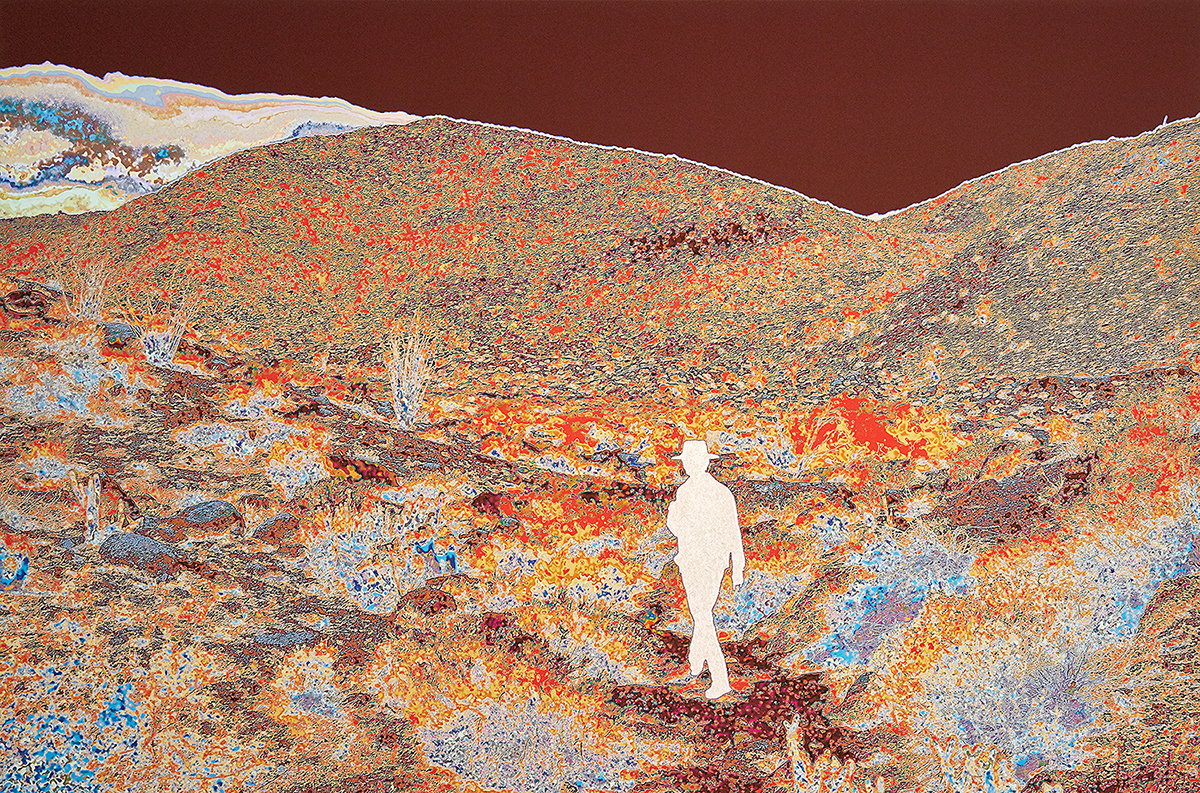
©John Brinton Hogan, Photographer Scouting Locations, South of Palm Springs, CA, March 2015 (Rainbow and Blood Red, with Ivory Pearl and Glitter Blister) 2019 28 x 42” (71 x 107 cm) Mixed media on cotton paper Unique

©John Brinton Hogan, Botanist and Volunteers Identifying Invasive Species, Anza Borrego Desert State Park, California, February, 2015 (Wine Red, Purple, and Teal with Yellow Glitter Blisters) 2018 20 x 34” (66 x 102 cm) Mixed media on cotton paper Unique
What has been your evolution from classic landscape photography to straddling the line of photography and painting?
I’ve long been interested in examining the relationship between humans and the landscapes they inhabit. The ways in which we manipulate and transform our environment to achieve various goals is fascinating to me.
My previous bodies of work had been what might be termed “straight photography,” with the creation of the finished image in the camera. Working as such seemed like a dead end, as I was already becoming tired by the number of photographs I was seeing via electronic screens each day.
My desire was to continue with the landscape as a principal component of my practice, but I was longing for some physical connection to the work. I needed to make objects, not images, and I started to experiment with old prints I had lying around. With each finished piece I got further away from photography, and closer to something else, the creation of which involved painting.

©John Brinton Hogan, Man Making Snapshot Near Raven Butte, Barry M. Goldwater Range, Arizona, March, 2014 (Rainbow with Bronze Pearl Blisters) 2018 22 x 37 1/4” (71 x 110 cm) Mixed media on cotton paper Unique
I remember being blown away by your work at the Medium Festival in San Diego…maybe in 2015? When did that jump in image making take place and how did your use of glitter begin?
Various life circumstances prevented me from making art for a few years, beginning in 2010. When I returned to the studio in about 2013 or 14, I decided I could not continue creating simple photographic images. A dear friend of mine, a supremely talented artist, advised me at the time that my best path forward was to “make things that freak out your friends.”
I took his words to heart and began to mine my childhood fears, projecting them onto concerns I had about the apparent disregard of our species has for its life-sustaining environment.
I began to focus my efforts on examining the human form as it inhabits landscapes. Artists, scientists, volunteers, campers and hikers- they all placed themselves in the wilderness for some purpose, which I would record by camera.
Using those pictures I’d made in the field, I employed a series of techniques to radically distort them. Once satisfied with the results, I would digitally paint out the human elements, redacting them, in a sense, from their natural surroundings. After a print was produced, I began to repaint the humans by hand… I used glitter and/or other sparkly materials, in a gesture that suggests a connection with the universe, perhaps like stars in the cosmos. In the end, the objects are beautiful but unsettling, with a childlike wonder offset by a paranoid uncertainty.

©John Brinton Hogan, Climber on the Ascent, Palo Verde Mountains Wilderness Area, near Blythe, California, Autumn, 2013 (Deep Aquamarine and Brown with White Glitter Crust) 2019 42 x 40” (107 x 102 cm) Mixed media on cotton paper Unique
You have a new process that involves blistering, can you describe the process?
“Blisters” simply describes the result of obsessively painting the same element over and over again- sometimes 20 or 30 times. The paint builds up, micron by micron, to create a 3-dimensional surface on the substrate, usually paper. I include in the title of each unique piece a reference to the physical construction of the object, and I came up with “blister” since that, to my eyes, is what it resembles.

©John Brinton Hogan, Gallery Director Making Snapshot of Artists Examining Saguaro Cactus, Barry M. Goldwater Range, December, 2017 (Red and Orange with Blue Glitter Crusts) 2019 40 x 60” (102 x 152 cm) Mixed media on cotton paper Unique
Can you share some of your influences?
My influences are wide-ranging and disparate; sci-fi movies and book illustrations, the “finish-fetish” movement, Caspar David Friedrich, 70’s rock album covers, racing-car paint schemes, Jay DeFeo, audio-engineering techniques, Albert Bierstadt, childhood nostalgia… the list goes on.
Your frames are masterful, can you speak to the construction?
I’m interested in presenting the objects I make in novel ways, and enjoy experimenting with that process in the same way I do with the work itself.
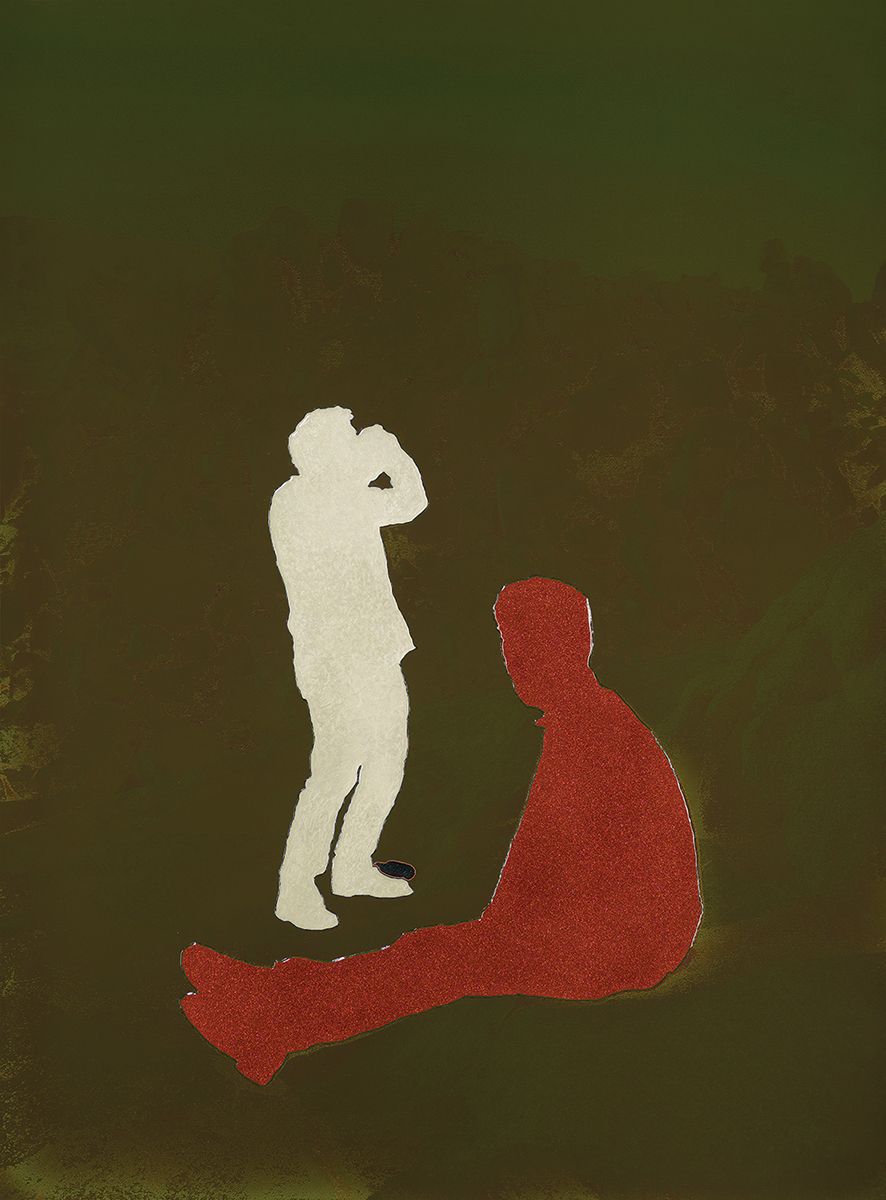
©John Brinton Hogan, Birdwatchers, Anza Borrego Desert State Park, California, Spring, 2009 (Green with Ivory and Orange Glitter Blisters) 2019 29 ½ x 22” (75 x 56 cm) Mixed media on cotton paper Unique
What is something you wish you had known at the beginning of your photo career?
This would apply to any type of art production: Make things that freak out your friends.

©John Briton Hogan, Recreational Hikers Near the Summit of Ghost Mountain, Anza-Borrego Desert State Park, California, November 2017 (Black,Turquoise, Brown, Red, and Orange with Gold Pearl and Glitter Blisters) 2019 42 x 64” Mixed media on cotton paper Unique

©John Brinton Hogan, Artist and Sons on Cliffs Near Watson’s Bay, NSW, Australia, Exact Date Unknown, Probably Winter, 2003 (Turquoise, Green, Olive, and Brown with Silver Holographic Glitter Blisters) 2019 42 x 54 ½ (107 x 138) cm Mixed media

©John Brinton Hogan, Artists Hiking Toward the Perimeter of the Utah Test and Training Area, August 2013 (Orange and Black with White, Green, and Blue Glitter Flocking 2014 14 ½ x 20 (36 x 51) cm Mixed media on cotton paper Unique
Posts on Lenscratch may not be reproduced without the permission of the Lenscratch staff and the photographer.
Recommended
-
Ragne Kristine Sigmond: Portraits of Painterly LightDecember 2nd, 2025
-
Mary Pat Reeve: Illuminating the NightDecember 1st, 2025
-
Ricardo Miguel Hernández: When the memory turns to dust and Beyond PainNovember 28th, 2025
-
Pamela Landau Connolly: Columbus DriveNovember 26th, 2025
-
MATERNAL LEGACIES: OUR MOTHERS OURSELVES EXHIBITIONNovember 20th, 2025

